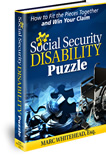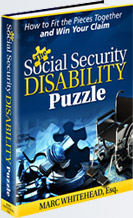
Marc Whitehead
Board Certified-Personal Injury Trial Law
Texas Board of Legal Specialization
Marc Whitehead
Board Certified-Social Security Disability Law
National Board of Social Security Disability Advocacy

Disability Lawyer in Houston: Social Security Disability
Free Social Security Disability eBook:
 Just click on the link below: The Social Security Disability Puzzle How to Fit the Pieces Together |
To better understand the Social Security Disability claim process, please accept a free copy of our eBook, The Social Security Disability Puzzle, by attorney Marc Whitehead.
Houston Social Security Disability / SSI Denials
Marc Whitehead & Associates’ disability lawyers in Houston assist clients throughout Texas who face Social Security Disability denial or delay of benefits after an initial claim with the government. Disability can pose overwhelming hardships to earning a living and providing for your family.
About Social Security Disability Benefits
If you suffer from an injury or disease that prevents you from working (or is expected to prevent you from working for one year or longer) then you may be entitled to Social Security Disability benefits.
Social Security Disability is a program set up under the federal Social Security Administration and is designed to help qualified disabled individuals who cannot work obtain their social security benefits earlier than the standard retirement age of 65.
To be entitled to these benefits, you must have paid into the social security system for approximately five out of the last ten years to be "fully insured" under the system. If you win your Texas disability claim, you will be entitled to back due benefits that begin to accrue 5 months after the "onset" of your disability, plus monthly disability payments in the future.
What Is A Board Certified Social Security Disability Advocate?
How is a Texas Disability Claim Filed & What is the Appeals Process?
Claims are initiated by filing a claim in person at the local district and branch Social Security office or by telephone by dialing (800) 772-1213. If a claim is denied at any level, you must appeal to the next level or your claim is dismissed and you must start over. There are four levels of administrative appeals of social security disability claims. They are:
- Initial determination
- Reconsideration determination
- Hearing before an administrative law judge (ALJ Hearing)
- Review by the appeals council
If all administrative appeals fail, a case may be filed in federal court. The time limit for all appeals, save one, is 60 days from the date of receipt of a decision. This is extended 5 days because of the time it takes to receive a decision by mail. The one exception is appealing an ALJ denial to the Appeals Council after there has been a federal court remand. This time limit is 30 days.
How Can I Win My Case?
It has been the experience of our Houston disability lawyers that most claims are denied at the first two stages of the appeal process (i.e. the Initial Determination and the Reconsideration stages.)
The biggest mistake claimants make is not appealing to the third level of appeal—the ALJ hearing. It is at this stage that the claimant will have their first live hearing before a judge. The claimant can present any evidence they have, including live testimony and they may argue their case to the judge. The ALJ hearing is basically a mini trial.
Do I Need a Disability Lawyer & How Can I Afford One?
Social Security Disability (SSD) claims can be difficult to pursue because of the complexity of the social security regulations and the appeals process. Recognizing this problem, the social security regulations allow for claimants to be represented by attorneys on a contingent fee basis. In other words, a legitimate claimant can hire an attorney to represent him with no money up front – the attorney gets paid a percentage of the past due benefits only if the claimant wins their case.
The standard contingency fee arraignment pays the attorney 25% of all past due benefits up to a maximum of $5,300 if the case is won before appealing to the federal district court. If a case must be appealed to federal district court the $5,300 maximum cap is lifted and the fee is 25% of all past due benefits. Marc Whitehead & Associates firmly believes that a claimant's chances of winning their claim is greatly increased by having an attorney represent them.
What Will a Houston Social Security Disability Lawyer Do For Me?
Every client is different and has different needs but below are just some of the things
our Houston disability lawyers may do to help you with your disability claim:
- Aid you in filling out all SSA forms;
- Evaluate your claim and advise you on the law and your options;
- Review your medical records and make suggestions for any additional testing required to prove your case;
- Supplement your claim file with additional medical records;
- File any appeals necessary and handle all SSA paperwork;
- Obtain medical reports and opinion evidence regarding your disability;
- Consult with qualified Vocational Experts to get opinion evidence rebutting the ALJ called Vocational Experts;
- Obtain and develop evidence regarding your “Residual Functional Capacity” that is the key to your disability claim;
- Correctly calculate your benefits;
- File a legal brief arguing the legal, medical and vocational issues in your case;
- File a lawsuit in Federal Court if necessary;
- Filing Your Motion for Summary Judgment and Responding to the Government's Motion for Summary Judgment filed against you.
What are the Social Security Administration’s Requirements to be Found Disabled?
The Social Security Act (the Act) provides that certain individuals who are “under a disability” shall receive disability benefits. 42 U.S.C. § 423(a)(1)(D). The statutory concept of “disability” is comprised both of a medical and a vocational element. The Social Security Act defines the term disability as the “inability to engage in any substantial gainful activity by reason of any medically determinable physical or mental impairment which can be expected to result in death or which has lasted or can be expected to last for a continuous period of not less than 12 months.”42 U.S.C. § 423(d)(1)(A). The foregoing is the medical component of the statutory definition of disability.
The Act also provides that a claimant will be found disabled only if his impairment or impairments “are of such severity that he is not only unable to do his previous work but cannot, considering his age, education and work experience, engage in any other kind of substantial gainful work which exists in the national economy, regardless of whether such work exists in the immediate area in which he lives, or whether a specific job vacancy exists for him, or whether he would be hired if he applied for work.” 42 U.S.C. § 423(d)(2)(A). The foregoing is the vocational component of the definition of disability.
The Social Security Administration (SSA) has implemented the foregoing definition of disability by applying the five-step sequential evaluation in deciding whether a claimant is disabled and therefore entitled to benefits under Title II (Social Security Disability Insurance) or Title XVI (Supplemental Security Income) of the Social Security Act. 20 C.F.R. §§ 404.1520 and 416.920. The process is commonly referred to as the “Sequential Evaluation.” It consists of a 5-step inquiry, with questions asked in a specific order, until a question is answered affirmatively or negatively in such a way that a decision can be made that a claimant is either disabled or not disabled. 20 C.F.R. §§ 404.1520(b)-(f) and 416.920(b)-(f).
What is the Five Step Sequential Evaluation Used to Determine Disability?
The questions are as follows:
(1) Is the claimant engaged in “Substantial Gainful Activity or Employment?”; if not then
(2) Does the Claimant have “Severe Mental or Physical Impairments” lasting more than 12 months or resulting in death?; if yes then
(3) Do these impairments “Meet or Equal the Severity of a Defined Medical or Psychological Listing?; if yes then the claimant is disabled according to a Medical Listing and you need go no farther, if no then proceed to steps four and five of the sequential evaluation which are vocational in nature;
(4) Can the claimant “Perform Any Past Relevant Work that Claimant Engaged in During the Previous 15 Years?”; If no
(5) Can claimant “Perform Any Other Available Work Given their Age, Education and Past Work Experience?”; if not then claimant is disabled according to vocational standards.
Any contrary finding will lead to a finding of “not disabled” by the SSA. It is important to note that the burden of proof is on the claimant at Steps 1-4, but shifts to the SSA at Step 5. The standard for both is by a preponderance of the credible evidence.
Disabled According to Medical Standards (Steps 1-3)
If a claimant is to be found disabled according only to medical standards, one must one look at steps one through three of the Five Step Sequential Evaluation. They are relatively straight forward.
At Step 1, claimant can’t be working at the “Substantial Gainful Activity” level, roughly defined as earning more than approximately $800/month or working on a full time basis regardless of monthly income.
At Step 2, the alleged impairments must be “severe” meaning the claimant’s impairment at some time in the past or present “significantly limited” the claimant’s ability to perform “basic work activities.” Basic work activities are defined in accordance with 20 C.F.R. §404.1521(b) as “the abilities and aptitudes necessary to do most jobs.” The alleged severe impairment must also meet the 12 month duration requirement or result in claimant’s death.
At Step 3 of the sequential evaluation process, a claimant is eligible for benefits if he or she has an impairment, or combination of impairments, which meets or equals the conditions found in the listing of impairments which describes impairments that are considered presumptively disabling. The claimant must satisfy all of the criteria of the listed impairment and they are very strict. There are fourteen adult listing categories that can be found officially at 20 C.F.R. §§ 404.1520(d), 416.920(d), Pt 404, Subpt. P. App.1. It has been this author’s experience that very few claimants satisfy the Step 3 listing requirement.
If that is the case, the claimant must proceed on further to satisfy the vocational standards of the sequential evaluation at Steps 4 and 5.
What is Residual Functional Capacity (RFC)?
At Steps 4 and 5 of the sequential evaluation, one must understand the concept and framework of the claimant’s “Residual Functional Capacity” (RFC). RFC is the individual’s maximum remaining ability to do sustained work activities in an ordinary work setting on a “regular and continuing basis,” and the RFC assessment must include a discussion of the individual’s abilities on that basis. At Step 5 of the sequential evaluation, “regular and continuing basis” means 8 hours a day, for 5 days a week, or an equivalent schedule.SSR 96-8p. Moreover, at Step 5, where solely non-exertional impairments are not involved, RFC must be expressed in terms of the exertional classifications of work: sedentary, light, medium, heavy, and very heavy work. SSR 96-9p. The SSA relies heavily on the Dictionary of Occupational Titles (DOT) for its classification of various jobs and their exertional requirements. The DOT lists over 10,000 individual jobs with each classified by its own RFC requirements. Each of the five exertional RFC levels—sedentary, light, medium, heavy, and very heavy—is defined in terms of the degree to which the seven primary strength demands of jobs are required. They are Sitting, Standing, Walking, Lifting, Carrying, Pushing and Pulling.
SEDENTARY WORK is defined as lifting no more than 10 pounds at a time, occasionally lifting or carrying articles like docket files, ledgers, and small tools, standing or walking no more than about 2 hours of an 8-hour workday and sitting should generally total approximately 6 hours of an 8-hour workday.
LIGHT WORK is defined as lifting no more than 20 pounds at a time, frequent lifting or carrying of objects weighing up to 10 pounds, standing or walking off and on, for a total of approximately 6 hours in an 8-hour workday, may involve sitting most of the time, but with some pushing and pulling of arm-hand or leg-foot controls which require greater exertion than in sedentary work. If someone can do light work, SSA determines that he or she also can do sedentary work, unless there are additional limiting factors such as loss of fine dexterity or inability to sit for long periods—20 C.F.R. §§ 404.1567(b) and 416.967(b).
MEDIUM WORK is defined as lifting no more than 50 pounds at a time, frequent lifting or carrying of objects weighing up to 25 pounds, and standing or walking off and on, for a total of approximately 6 hours in an 8-hour workday. As in light work, sitting may occur intermittently during the remaining time. If someone can do medium work, SSA determines that he or she also can do light and sedentary work—20 C.F.R. §§ 404.1567(c) and 416.967(c).
“The term “occasionally” means “occurring from very little up to one-third of the time. The term “frequent” means “occurring from one-third to two-thirds of the time.”—SSR 83-10
Disabled According to Vocational Standards (Steps 4 and 5)
At Step 4 of the sequential evaluation a claimant must prove that he can no longer perform his “past relevant work.” In determining whether a claimant can perform their past relevant work, the SSA should normally only address work that; 1) the claimant performed in the prior 15 years; 2) the work lasted long enough for the claimant to learn to do it; and 3) the work was substantial gainful activity. A determination will be made as to the claimant’s Residual Functional Capacity (RFC) after the onset date of the alleged disability and then compared with the RFC of each job the claimant performed in the past 15 years as defined by the DOT. If the claimant’s RFC is less than that of any past relevant jobs, then the claimant will have met the burden of Step 4. For example, if a claimant had three past relevant jobs, all at the “light” RFC description per the DOT and further the claimant’s RFC is determined to be at the “Sedentary” level, then the claimant will have met their burden at Step 4. If however, one of the claimant’s past relevant jobs was classified as “sedentary”, then the claimant would be found not disabled, as he was found to have a sufficient RFC to perform that one job. In other words, claimant must eliminate all past relevant jobs he has held in the last 15 years in order to meet his burden. If he does so, he moves on to Step 5.
At Step 5, the final step of the sequential evaluation, a claimant must not be able to perform any “other work” that is generally available considering claimant’s RFC, age, education, and past work experience. If claimant cannot, SSA will find him disabled. 20 C.F.R. §§ 404.1520(f) and 416.920(f). At this step, the burden of proof is shifted to the SSA. It is at this point in the sequential evaluation that the claimant’s age will become decisive. The regulations provide that older age is an increasingly adverse vocational factor for persons with severe impairments. The chronological ages 45, 50, 55 and 60 may be critical to a decision. However, the regulations also provide that age categories are not applied mechanically in borderline situations.
The SSA has developed a set of 82 Medical-Vocational Guidelines, known as the “grids.” The grids reflect, at Step 5 of the sequential evaluation, SSA’s analysis of the impact of the statutory vocational factors of disability—age, education, and previous work experience—in combination with the medical factor—residual functional capacity (RFC)—on an individual’s ability to adjust to other work. The grid rules resolve the step-five issue by taking administrative notice of the fact that given a claimant’s sedentary, light, or medium RFC, and also “considering his age, education, and work experience,” the claimant can or cannot engage in work which exists in significant numbers in the national economy. For a claimant whose medical-vocational profile (RFC, age, education, and previous work experience) matches that of one of the grid rules, that grid rule conclusively determines whether or not the statutory definition of “disability” is satisfied. Of the 82 numbered grid rules in the three medical-vocational tables, only 17 rules direct a finding of “disabled.”
If a claimant’s exertional RFC differs from the technical “full range” definitions of sedentary, light, or medium work upon which the three medical-vocational tables are based—for example the claimant’s RFC for exertional activity falls between sedentary and light work—then the claimant has exertional limitations that are not described by the grids. 20 C.F.R. Pt. 404, Subpt. P, App. 2, § 200.00(d)-(e). For such claimants, the grids are used as a framework for decision making.
A review of the “grid” rules indicates that for a claimant under the age of 50, the standard of disability is extremely stringent and appears to be impossible. Disability for such individuals requires proof that they can do much less than a full or wide range of sedentary work, described by SSR 83-12 as a “significance compromise” of the sedentary occupational base. This means, according to SSR 96-9p, that jobs for them do not exist in significant numbers. Although this is frequently difficult, it is not impossible.
In order to prove that the sedentary occupational base is significantly compromised, you will usually look for a combination of exertional and non-exertional impairments. Each additional impairment whittles away the range of sedentary work that a claimant is capable of doing to arrive at the point where jobs do not exist in significant numbers.
For claimants between 50-54, it is generally the rule that a claimant only be unable to perform at the Light RFC level and above, assuming no transferable skills and all other steps are met. The standard is eased further when a claimant reaches the 55-59 category and so on.
A complicating factor when using the Grids to determine disability is the issue of transferable work skills. The Medical-Vocational Guidelines or “grids”, indicate that a claimant is never disabled if the claimant has skills transferable to jobs within his or her RFC that exist in significant numbers.
What are the Non-Disability Requirements that Must be Met to Get Benefits?
Social Security Disability
The social security disability program for workers functions like an insurance plan. There are requirements that a claimant for disability insurance must have: 1) Contributed to the program (paid social security taxes) over a sufficiently long period to be “fully insured” and 2) Contributed to the program recently enough to have “disability insured status.”
In short, a worker must have paid social security taxes in order to be “insured,” just like paying the premiums for a private insurance policy. After stopping work (and stopping paying social security taxes), there will come a time when insured status will lapse, just like with a private insurance policy. Contributions are counted in “quarters of coverage.” The rule for disability insured status for those over 31 years old is that they must have 20 quarters of coverage out of the 40 calendar quarters before they become disabled. 20 C.F.R. 404.130. This is referred to as the 20/40 rule. Significant work in five years out of the last 10 years usually satisfies this requirement. 2
Supplemental Security Income
The Supplemental Security Income (SSI) program is a federal welfare program for the disabled, blind and those over 65. To meet all the requirements to receive SSI a claimant must:
- Be “disabled” using the same definition as is used for the social security disability program
- Meet the income and asset requirements of the SSI Program
- Be a U.S. citizen or fall into the group of limited exceptions to the citizenship rule; The asset limitation beginning in 1989 is $2,000 for an individual and $3,000 for a couple. Several assets are excluded, the most significant of which are the home of any value and one car of any value if it is used for work or to obtain medical care. See 20 C.F.R. 416.1210 et seq.
Do Not Delay – Contact Us!
If you've received an unfair Texas Social Security Disability denial or delay of benefits after an initial claim, contact a Houston injury lawyer at Marc Whitehead & Associates today for a FREE case evaluation to recover benefits and provide for your family.







